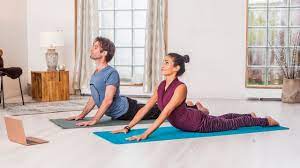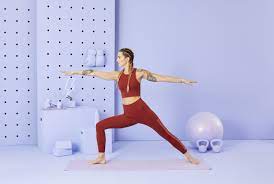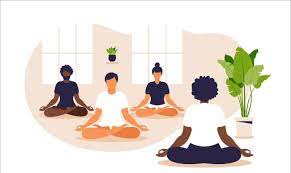A Beginner’s Journey to Daily Wellness through Yoga Practice
Yoga has been practiced for thousands of years, and its benefits for physical and mental health are well-documented. However, it can be intimidating to begin a yoga practice, and many beginners don’t know where to start. This blog post is for those just beginning their journey to daily wellness through yoga. We will cover the basics of yoga, how to set up a home practice, and the many benefits of a regular yoga practice.
What is Yoga and Why is it Important for Daily Wellness?

Yoga is an ancient practice that has gained immense popularity in recent years due to its numerous health benefits. It involves physical postures, breathing techniques, and meditation to improve the overall well-being of an individual.
Yoga is important for daily wellness because it not only helps improve physical fitness but also mental and emotional health. It provides a holistic approach to well-being, helping individuals develop a sense of balance, calmness, and inner peace.
The physical postures in yoga, also known as asanas, help to stretch and strengthen muscles, improve flexibility, and increase blood flow throughout the body. This leads to improved circulation, a boost in energy levels, and a reduction in stress and tension.
Breathing techniques, or pranayama, help to improve lung function and increase oxygen levels in the body. This leads to a calmer and more focused mind, which can be beneficial for individuals dealing with anxiety, depression, or stress-related disorders.
Meditation in yoga is a practice that helps individuals develop mindfulness and improve their ability to concentrate. It involves focusing on the breath and quieting the mind, which can help reduce stress and anxiety levels.
In summary, yoga is important for daily wellness because it offers a holistic approach to health that addresses physical, mental, and emotional well-being. With regular practice, individuals can improve their overall health and experience a greater sense of balance, calmness, and inner peace.
How to Get Started with a Yoga Practice

Starting a new practice can be intimidating, especially when it comes to something as physical and personal as yoga. However, with a few simple steps, getting started with a yoga practice can be an accessible and enjoyable process.
- Find a Good Instructor: While practicing yoga at home is certainly an option, having a knowledgeable instructor can be helpful for beginners. A teacher can guide you through proper alignment, offer modifications, and give you feedback to help improve your practice.
- Start Slow: It’s important not to push yourself too hard in the beginning. Begin with a gentle or beginner’s class and work your way up to more advanced practices as you feel more comfortable.
- Invest in a Good Mat: While a mat is not essential to practice yoga, having a quality one can make a big difference in your comfort and stability during poses. Look for one that provides enough cushioning but is not too slippery.
- Wear Comfortable Clothes: Yoga requires a lot of movement, so make sure you wear clothes that allow you to move freely. Breathable and stretchy fabrics like cotton and spandex are ideal.
- Be Open-Minded: Yoga is a holistic practice that focuses on physical, mental, and spiritual well-being. Don’t be afraid to try new things or embrace different approaches. Keeping an open mind will help you get the most out of your practice.
Starting a yoga practice can be a powerful way to improve your overall wellness. With a bit of preparation and patience, anyone can begin a journey toward greater physical and mental health through the practice of yoga.
Essential Yoga Poses for Beginners

If you’re just starting out on your yoga journey, it can be overwhelming to know where to begin with all the different poses out there. Here are some essential yoga poses for beginners to get you started:
- Mountain Pose (Tadasana): Stand tall with your feet hip-width apart, grounding down through your feet and lifting through the crown of your head.
- Downward-Facing Dog (Adho Mukha Svanasana): Start on your hands and knees, then lift your hips up and back into an inverted V-shape.
- Warrior II (Virabhadrasana II): Step your right foot back and bend your left knee, with your arms extended out to the sides.
- Child’s Pose (Balasana): Come to a kneeling position and stretch your arms forward, resting your forehead on the mat.
- Cobra Pose (Bhujangasana): Lie on your stomach and lift your chest off the mat, keeping your elbows close to your sides.
These poses will help you build strength, flexibility, and balance in your body, while also helping to calm your mind. As you progress in your yoga practice, you can explore more advanced poses and variations. But for now, focus on these basics and remember to listen to your body’s limits and take breaks when you need them.
Incorporating Yoga into Your Daily Routine

Yoga is a great way to promote physical, mental, and emotional well-being. But many people are put off by the thought of dedicating hours each day to yoga practice. Fortunately, you don’t have to spend hours on your mat to reap the benefits of yoga. With a little planning and creativity, you can incorporate yoga into your daily routine in ways that are easy, practical, and enjoyable.
Here are some simple ways to make yoga a part of your daily routine:
- Start with a morning stretch: As soon as you wake up, take a few minutes to stretch your body. You can do a few rounds of Sun Salutations, Cat-Cow, or any other yoga pose that feels good to you. This will help you wake up your body and mind, improve circulation, and prepare you for the day ahead.
- Take a yoga break: Instead of taking a coffee break, take a yoga break. Find a quiet spot at work, or at home, and do a few minutes of yoga. This can be as simple as doing a few seated stretches, or taking a short walk and doing some standing poses. This will help you release tension, improve focus, and reduce stress.
- Do yoga while watching TV: Instead of zoning out in front of the TV, try doing some yoga while you watch. This can be as simple as doing some seated stretches, or more active poses like Warrior II or Tree pose. You can also do some yoga during commercial breaks or between episodes.
- Take a yoga class: If you’re finding it difficult to incorporate yoga into your daily routine, try taking a yoga class. Many studios offer classes before or after work, or during lunch breaks. This will help you stay motivated, and you’ll also get the added benefit of having a teacher to guide you through your practice.
Incorporating yoga into your daily routine doesn’t have to be complicated or time-consuming. With a little creativity and commitment, you can make yoga a part of your daily life, and experience the many benefits that come with regular practice.
The Benefits of Daily Yoga Practice

Yoga has been practiced for thousands of years and for good reason. Daily yoga practice has numerous physical, mental, and emotional benefits that can improve your overall health and well-being. Here are just a few of the benefits you can expect to experience:
- Increased flexibility and strength: Yoga poses gently stretch and strengthen your muscles, which can improve your flexibility and overall range of motion. This can lead to fewer aches and pains and improved posture.
- Improved balance and coordination: Many yoga poses require you to balance on one foot or hand, which can improve your overall balance and coordination. This can be especially beneficial for older adults who may be at risk of falling.
- Reduced stress and anxiety: Yoga has been shown to reduce levels of the stress hormone cortisol, which can help you feel calmer and more relaxed. Regular yoga practice can also help you develop better coping skills for dealing with stress.
- Improved sleep: Many people report better sleep quality and quantity after starting a regular yoga practice. This may be due to the stress-reducing effects of yoga, as well as its ability to calm the mind and promote relaxation.
- Boosted immune system: Regular yoga practice can help boost your immune system by reducing inflammation and increasing blood flow. This can help your body fight off infections and illnesses more effectively.
These are just a few of the many benefits of daily yoga practice. With regular practice, you may also experience improved digestion, lower blood pressure, and a greater sense of overall well-being. So why not start your own yoga practice today?
Mindfulness and Meditation in Yoga

In addition to the physical benefits of yoga, the practice also includes mindfulness and meditation. Mindfulness is the practice of being present at the moment, paying attention to your thoughts and surroundings without judgment. Meditation is a technique used to train the mind to focus and be more aware.
Yoga provides an opportunity to bring mindfulness and meditation into your daily routine. During your practice, focus on your breath and movement, bringing attention to each moment. If your mind starts to wander, gently bring it back to the present moment. As you become more mindful, you may begin to notice patterns in your thoughts and emotions, allowing you to become more aware of how they affect your daily life.
Meditation can also be incorporated into your yoga practice. After completing a yoga sequence, take a few moments to sit or lie down and focus on your breath. You may choose to use a guided meditation or simply sit in silence. This can help you to feel more relaxed and centered, leaving you feeling refreshed and ready to face the day.
Overall, incorporating mindfulness and meditation into your yoga practice can lead to improved mental and emotional well-being, helping you to manage stress and anxiety. It can also enhance your ability to focus and concentrate, improving your overall productivity and quality of life. So why not give it a try and see the positive impact it can have on your daily wellness?
Finding Your Own Yoga Practice

As you continue to practice yoga, you will naturally begin to develop a deeper understanding of your body and your mind. You may find that certain poses feel more challenging, while others feel more relaxing. This is where you can start to personalize your yoga practice and create a routine that works best for you.
First, consider your goals for your yoga practice. Do you want to focus on building strength? Flexibility? Finding inner peace and calm? Depending on your goals, you may want to incorporate different types of yoga into your practice. For example, if you want to focus on building strength, you may want to try power yoga or vinyasa flow classes. If you’re looking for more relaxation, restorative yoga or gentle hatha yoga may be more your style.
Next, consider how much time you have available for your practice. Some days you may only have 15 minutes, while other days you may have an hour or more. You can customize your yoga practice to fit your schedule, whether that means doing a quick flow in the morning or a longer practice in the evening.
Finally, don’t be afraid to experiment and try new things. As you continue to practice yoga, you may find that your preferences change and evolve. Try out different poses, styles, and teachers until you find what resonates with you. Remember, your yoga practice should feel nourishing and fulfilling, so don’t be afraid to tailor it to your individual needs.
By finding your own yoga practice, you can create a routine that supports your physical and mental well-being, and ultimately enhances your daily life.
